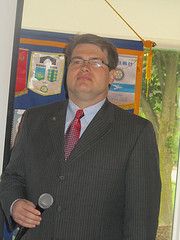Who will be tomorrow's Rotarians?
C. Lee Smith, President/CEO of Ad-ology (see www.ad-ology.com )
 "Who will be tomorrow's Rotarians, " asked Lee Smith, District 6690 Interact Director, "and how can we best reach them so that Rotary's work can be continued?"
"Who will be tomorrow's Rotarians, " asked Lee Smith, District 6690 Interact Director, "and how can we best reach them so that Rotary's work can be continued?"
This past December, Lee's company, Ad-ology, surveyed over 2,111 people to find out the "psychographics" of current and potential service club members.
"Current service club members have characteristics not at all surprising to most of us here today," Lee said, "but potential members differ in some surprising ways from those who are here today." Most current service club members are male (58% of those surveyed), 45 - 74 years of age, suburban, affluent, married, well-educated, likely to be church goers, interested in sports such as college football and basketball, and most likely to be reached by a Sunday newspaper, radio, television, and email.
Potential members, as identified in the survey, differ from this profile in important ways while still having as strong a commitment to "volunteering for a cause" and "to be involved in their community."
While still well-educated and primarily suburban, they tend to be younger, "mostly in the 25 - 44 age bracket." They are more likely to be women: "about 63% of those identified as being potential service organization members were women." They are "at least so far, a little less affluent and more likely to be interested in debt consolidation." They are less interested in sports and, "in spite of our perception that they are primarily interested in online interaction, very are interested in socializing in person."
They can still be reached through television and the Sunday papers, but they are "far more likely than current social organization members to be reached through the Internet and social media, with 63% of them being regular users of Facebook."
"So," asked Lee, "in light of these differences, how can we reach these potential Rotarians? We will have to develop new methods."
Lee recommended targeting mobile media, especially "using YouTube videos to broadcast our service projects, which are far more likely to attract them than our club meetings. Remember, they want to join a cause, not to be in a club."
He explained that we must work harder to "find ways to attract women to Rotary," that "we need to increase diversity," and "we must find ways for people to be active rather than just to donate big money to causes." Lee added that "we need to be more flexible about our meeting attendance--these potential new members may not make every meeting but they will turn out heavily for social and service events."
What Lee said reminded at least one Rotarian of Rotary's "Fifth Avenue of Service: New Generations." "The Avenue of New Generations recognizes the positive change implemented by youth and young adults involved in leadership development activities, community and international service projects, and exchange programs that enrich and foster world peace and cultural understanding" (
http://www.rotary.org/en/mediaandnews/news/pages/100428_col10_5avenue.aspx
). Lee's message challenges our Club, and all of Rotary, to change and adopt effective new ideas and procedures to guarantee that Rotary's great work continues here and internationally. Lee made us think about how our club can grow and flourish in changing times. We are already making great strides in how we communicate, but we will have to continue to make ourselves attractive in new ways to bring the best and most committed new Rotarians into Dublin AM Rotary and ensure that our tradition of service goes on in the future as proudly as it has been sustained in the past.